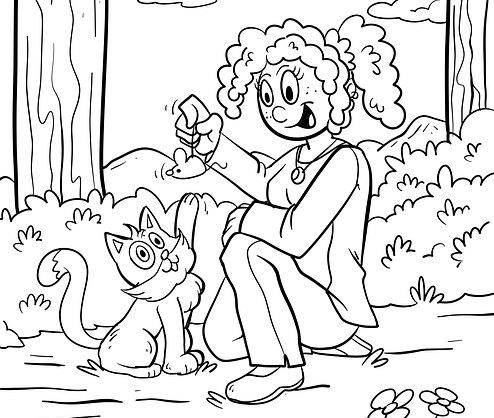Create a Template

You don't want to be spending time for each book you create, working out such things as paper size, fonts, heading sizes, creating a table of contents and so on.
It's really important to make all those decisions just once and create a Word document that you can use as a template going forward.
Just like a line drawing that you can color in, instead of producing the whole thing from scratch, it's a major time saver, as well as ensuring that your books follow a consistent format.
To create a template in Word that you can use for both Kindle and paperback publications, open a new blank document in Word and then:
- Go to Layout >> Size >> More Paper Sizes. In the Paper tab, select Custom Size and set it to Width: 6" or 15.24cm and Height: 9" or 22.86cm. From the Apply To dropdown, select Whole Document. Click the OK button.
- In Word's ribbon menu, modify the heading styles as follows:
- Chapter Heading - Calibri (body), 20 pt, Left-Justified.
- Normal - Literata, 12 pt, Left and Right (Fully) Justified.
- Heading 1 - Calibri (body), 18 pt, Left-Justified.
- Heading 2 - Calibri (body), 16 pt, Left-Justified.
- Heading 3 - Calibri (body), 14 pt, Left-Justified.
- Title - Calibri (Body), 28 pt, Centered.
- Sub-Title - Calibri (Body), 11 pt, Centered.
- Create skeleton pages and use Insert >> Page Break to separate them.
- Title page. Contains your book's title using Title style, followed by your book's sub-title (optional but recommended) using Sub-Title style.
- Copyright and Enquiries page. This is the wording I use:
Copyright © 2022 by [author]
All rights reserved. This book or any portion thereof may not be reproduced or used in any manner whatsoever without the express written permission of the publisher except for the use of brief quotations in a book review.
Comments or enquiries may be left in the Contact page at
https://author-name.com/contact/ - Change the copyright year to the year of publication. If you don't have an author website (but you should) remove the reference to leaving a comment.
- Disclaimer page. Not required for fiction. This is the wording I use:
Please note the information contained within this document is for educational and entertainment purposes only. Every attempt has been made to provide accurate, up to date, reliable and complete information. No warranties of any kind are expressed or implied. Readers acknowledge that the author is not engaging in the rendering of legal, financial, medical or professional advice.
By reading this document, the reader agrees that under no circumstances is the author or publisher responsible for any losses, direct or indirect, which are incurred as a result of the use of information contained within this document, including, but not limited to, errors, omissions, or inaccuracies. - Contents page. From the ribbon, select the References tab and then Table of Contents. Use Automatic Table 1. This will produce a table of contents labeled "Contents" and showing down to Heading 3.
- Instead of a normal page break, the Contents page should be followed by a section break. This is because from this point on, we will be inserting headers, footers and page numbers. To insert a section break, use Layout >> Breaks >> Section Breaks >> Next Page.
- Then use Insert >> Header and Insert >> Footer. In the Header, Insert the book's title and sub-title (you can copy and paste these from the Title page) and in the Footer, insert the page number, centered. Then create the normal page, that you will use as the model for most of your content.
- Normal page. Enter the following items on this page, so that you can see how everything will look:
"Chapter" using the Chapter style.
"Heading 1" using the Heading 1 style.
"Heading 2" using the Heading 2 style.
"Heading 3" using the Heading 3 style.
"Paragraph" using the Normal style.
I also like to start the first paragraph in each chapter with a drop cap. Place the cursor immediately before the first letter and select Insert >> Drop Cap >> Dropped. - The Rest of the Books page. If this book is in a series, list them here and tempt your readers to buy more in the series with some teaser information. If you have other books, list them here as "Other Titles by the same Author". If you have a website, invite your reader to sign up to be informed about forthcoming titles and other information.
This is all about establishing yourself as a brand. - The About the Author(s) page. Don't underestimate the importance of this page as part of reinforcing your brand. Readers love to know stuff about their authors, especially what they look like. Include a photo of yourself and write an interesting, personal bio wrapped around the photo. (To wrap text around an image, right-click on the image, select Wrap Text and experiment with the various options. You may need to change the size of the image to get the best effect.
The bio should be reasonably substantial and include personal information, as readers are always curious about the life, upbringing and personal choices of the person whose work they are reading. It should also include some information that connects them to the writing of this book.
- Normal page. Enter the following items on this page, so that you can see how everything will look:
Save two copies of the template, one to update with your book's details and the other to come back to for your next book!
Join the Discussion
Write something…
manna4star2
Premium
Phil, I started a KDP Account a few days ago and published my first e-book. Today I published 3 more. Your training walked me right through it. But I am still lost. I have a couple of more papers I have written and want to publish them also. But I have run into a slight snag right now with one of them and I am going to send you a PM. it is currently 2124 Monday night here in Rogers, Arkansaw.
Sonny
Sonny
roysinOnline
Premium
Timely training for me, Phil. My first book is in "production", and even if it is a long term project of mine (not at the top of my priority at the moment), this training come in very handy. It fits very well into the long term plans of rebooting my business and my new niche website.
I will be following the next parts of the series with eyes wide open :-)
Roy
I will be following the next parts of the series with eyes wide open :-)
Roy
Freedomseekr
Premium
Great training for getting started on publishing books on Amazon, Phil! This has been an idea of mine to do for awhile now, although I did work with a couple others in the past, I didn't have much to do with the actual setting up all this on Amazon. So, this will help a lot once I get going on it as I'm still trying to decide on what type of book to do, lol.
Thanks for sharing!
Best wishes :) ~Sherry
Thanks for sharing!
Best wishes :) ~Sherry
Nina64
Premium
Thanks so much for this great information. My niche is on gardening for the beginner. Can I just incorporate the information from my articles on my website into a book. I see how I can create a series from the different menus that I have. Do you think that's a good idea or is it being redundant.
Nina
Nina











